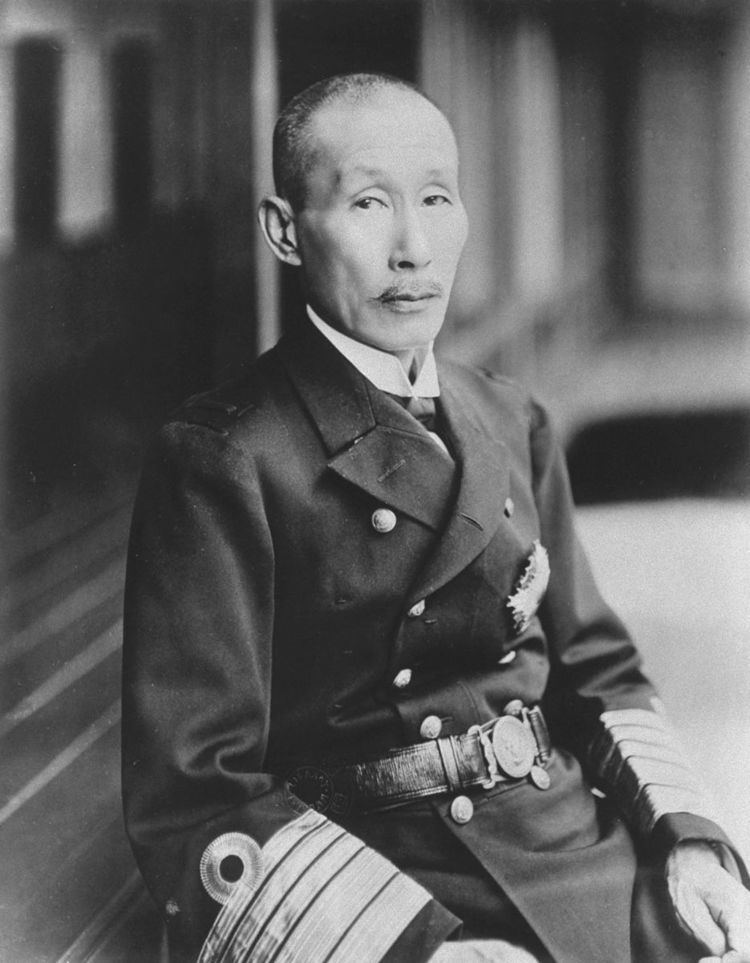Succeeded by Uchida Kosai (Acting) Political party Independent | Name Kato Tomosaburo | |
 | ||
Died 24 August 1923(1923-08-24) (aged 62)Tokyo, Japan | ||
Marshal-Admiral Viscount Katō Tomosaburō (加藤 友三郎, 22 February 1861 – 24 August 1923) was a career officer in the Imperial Japanese Navy, cabinet minister, and 21st Prime Minister of Japan from 12 June 1922 to 24 August 1923.
Contents
Biography

Born in Hiroshima, Aki Province (modern Hiroshima Prefecture) to a samurai family, Katō enrolled in the 7th class Imperial Japanese Naval Academy and graduated second out of a class of 30 cadets. He specialized in both in naval artillery and in navigation.
Naval career
After his commissioning as lieutenant, Katō served on the corvette Tsukuba in 1887, followed by the cruiser Takachiho. During the First Sino-Japanese War, he served in a combat position as gunnery officer on the cruiser Yoshino. After the end of the war, he served in numerous staff positions before promotion to commander. He was executive officer on the battleship Yashima, and captain of the Tsukushi. He was promoted to rear admiral on 1 September 1904.
During the Russo-Japanese War, Katō served as chief of staff to Admiral Tōgō Heihachirō on the battleship Mikasa, assisting in Japan's victory at the Battle of Tsushima. During this time, he suffered from a very weak stomach, and was vomiting as he issued orders throughout the battle, despite having taken large amounts of medication.
Katō became Vice Minister of the Navy in 1906, and was promoted to vice admiral on 28 August 1908. In 1909, he was appointed commander of the Kure Naval District, and in 1913 became Commander in Chief of the Combined Fleet.
Katō became Minister of the Navy in August 1915, days before his promotion to full admiral on 28 August 1915. He served in this post in the cabinets of Ōkuma Shigenobu, Terauchi Masatake, Hara Takashi, and Takahashi Korekiyo. Under Hara and Takahashi, Katō was Japan's chief commissioner plenipotentiary to the Washington Naval Conference, and worked with Ambassador Shidehara Kijurō in the negotiations that led to the Five-Power Treaty.
As Prime Minister
Following his return to Japan, Katō was appointed 21st Prime Minister of Japan in recognition of his performance at the Washington Naval Conference. His cabinet consisted mainly of bureaucrats and members of the House of Peers, which proved unpopular with the Imperial Japanese Army. During his tenure as prime minister, Katō implemented the provisions of the Washington Naval Agreement, withdrew Japanese forces from Shantung in China and ended Japanese participation in the Siberian Intervention. Katō succumbed to late-stage colon cancer and died a little over a year into his term.
Katō was given the honorary rank of Marshal Admiral the day before his death, and posthumously awarded the Grand Cordon of the Supreme Order of the Chrysanthemum and his title raised to shishaku (viscount).
His death came only a week before the Great Kantō earthquake of 1923, and therefore Japan was without a prime minister during that disaster.
Katō's grave is at Aoyama Cemetery, Tokyo.
Honors
From the corresponding article in the Japanese Wikipedia
